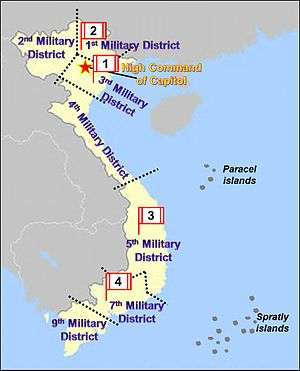Subdivisions of Vietnam
| Administrative divisions of Vietnam |
|---|
| Province-level |
|
| District-level |
|
| Commune-level |
|
Vietnam is a unitary state in South East Asian. Vietnam is officially subdivided into 3 administrative tiers:
- First tier or province-level (cấp tỉnh): provinces (tỉnh) and municipality (thành phố trực thuộc trung ương)
- Second tier or district-level (cấp huyện): rural districts (huyện), urban districts (quận), provincial cities (thành phố trực thuộc tỉnh) and towns (thị xã)
- Third tier or commune-level (cấp xã): communes (xã), wards (phường) and townships (thị trấn)
The fourth tier or village-level also exists as hamlet (xóm, ấp) and village (làng, thôn, bản). However this is not an official tier.
Administrative subdivisions
Structural hierarchy
| Level | 1st | 2nd | 3rd |
|---|---|---|---|
| Division Type | Municipality (Thành phố trực thuộc trung ương, 城舖直屬中央) | Urban district (Quận, 郡) | Ward (Phường, 坊) |
| District-level town (Thị xã, 市社) |
Ward (Phường, 坊) | ||
| Rural commune (Xã, 社) | |||
| Rural district (Huyện, 縣) |
Commune-level town (Thị trấn, 市鎮) | ||
| Rural commune (Xã, 社) | |||
| Province (Tỉnh, 省) |
Provincial city (Thành phố trực thuộc tỉnh, 城舖直屬省) | Ward (Phường, 坊) | |
| Rural commune (Xã, 社) | |||
| Rural district (Huyện, 縣) | Rural commune (Xã, 社) | ||
| Commune-level town (Thị trấn, 市鎮) | |||
| District-level town (Thị xã, 市社) | Ward (Phường, 坊) | ||
| Rural commune (Xã, 社) | |||
Province-level
There are:
- 5 municipalities (also known as centrally-controlled cities): Ha Noi, Ho Chi Minh City, Hai Phong, Da Nang and Can Tho
- 58 provinces
The local authority at province-level includes:
- People's Council (hội đồng nhân dân) - legislative branch: headed by a Chairman
- People's Committee (ủy ban nhân dân) - executive branch: headed by a Chairman
- People's Court (tòa án nhân dân) - judiciary branch: headed by a Chief Judge
- Committee of the Communist Party (ban chấp hành đảng bộ): headed by a Secretary
District-level
see also List of district-level subdivisions in Vietnam
The provinces are subdivided into provincial cities, towns (for urban area) and rural districts. Normally the provincial city or town is the capital of that province.
The municipalities are subdivided into rural districts and urban districts. There is no official capital of the municipality but usually the seat of local authority is located at a central urban district.
Since 2015 there are:
- 70 provincial cities
- 54 towns
- 49 urban districts
- 542 rural districts
The rural districts can be upgraded to towns which can be upgraded to provincial cities.
The local authority at district-level includes:
- People's Council (hội đồng nhân dân) - legislative branch: headed by a Chairman. However, since 2008, Vietnam started to abolish the People's Council at some districts and urban districts.
- People's Committee (ủy ban nhân dân) - executive branch: headed by a Chairman
- People's Court (tòa án nhân dân) - judiciary branch: headed by a Chief Judge
- Committee of the Communist Party (ban chấp hành đảng bộ): headed by a Secretary
Commune-level
The provincial cities and towns are subdivided into wards (for urban area) and communes (for rural area). There is no designated capital for provincial cities or towns, but usually the seat of local authority is located in a central ward.
The urban districts are subdivided into wards. The rural districts are subdivided into townships (for urban area) and communes (for rural area). There is no designated capital for urban and rural districts, but usually the seat of local authority is located in a central ward or central township
Since 2015 there are:
- 590 townships
- 1581 wards
- 9043 communes
The communes can be upgraded to townships (in rural districts) or wards (in provincial cities or towns).
The local authority at commune-level includes:
- People's Council (hội đồng nhân dân) - legislative branch: headed by a Chairman. However, since 2008, Vietnam started to abolish the People's Council at some wards.
- People's Committee (ủy ban nhân dân) - executive branch: headed by a Chairman
- Committee of the Communist Party (ban chấp hành đảng bộ): headed by a Secretary
Other subdivisions
Apart from administrative divisions, Vietnam is also divided into geographical regions, electoral divisions and military regions.
Geographical regions

Vietnam is geographically divided into:
- Northern Vietnam (Bắc bộ): Northwest (Tây Bắc bộ), Northeast (Đông Bắc bộ) and Red River Delta (đồng bằng sông Hồng)
- Central Vietnam (Trung bộ): North Central Coast (Bắc Trung bộ), South Central Coast (Nam Trung bộ) and Central Highland (Tây nguyên)
- Southern Vietnam (Nam bộ): Southeast (Đông Nam bộ) and Mekong Delta (đồng bằng sông Cửu Long)
Electoral divisions
For electoral purpose, each province or municipality is divided into electoral units (đơn vị bầu cử) which are further divided into voting zones (khu vự bỏ phiếu). The number of electoral divisions varies from election to election and depends on the population of that province or municipality.
Since the parliamentary election in 2011, there are 183 electoral units and 89,960 voting zones.
Military regions

Vietnam People's Army is organised into 8 military regions:
- High Command of Capital Hanoi (Bộ Tư lệnh Thủ đô Hà Nội) in Ha Noi
- 1st Military Region (Vietnam People's Army) (Quân khu 1) in Northeast
- 2nd Military Region (Vietnam People's Army) (Quân khu 2) in Northweas
- 3rd Military Region (Vietnam People's Army) (Quân khu 3) in Red River Delta
- 4th Military Region (Vietnam People's Army) (Quân khu 4) in North Central Coast
- 5th Military Region (Vietnam People's Army) (Quân khu 5) in South Central Coast and Central Highland
- 7th Military Region (Vietnam People's Army) (Quân khu 7) in Southeast
- 9th Military Region (Vietnam People's Army) (Quân khu 1) in Mekong Delta